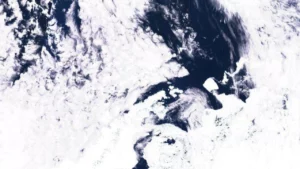Biggest Iceberg. That massive iceberg we’ve known since ’86 as A23a, parked in Antarctica’s Weddell Sea for almost three decades, has finally decided to get a move on. The thing’s been a whopping 1,312 feet thick and spread across 1,544 square miles—larger than London itself!
Iceberg on the Move
According to NOAA climate scientists, this colossal block of ice is finally starting to drift away from the seafloor. It’s making its first journey since parting ways with the Filchner-Ronne ice shelf all those years ago.

Climate Change and Snowfall
Here’s the deal: Less snow falling isn’t just about needing less shovel work. It’s a big deal, threatening to mess up our planet’s balance and shake up food and water supplies for billions of folks.
What’s the Future of Snowfall?
As temperatures rise because of human-made pollution, snow might just be history. Instead of the fluffy stuff, more rain might fall, especially with global warming doing its thing.
Snowfall’s Secret
Snowfall won’t simply disappear in a straight line as the thermometer climbs. Climate scientists like Justin Mankin reckon there’s a tipping point. Once temperatures hit a certain level, say bye-bye to a lot more snow.
Snow: Sun Shield or Warming Tool?
Turns out, snow isn’t just pretty—it’s essential. Like a car’s sunshade, snow reflects sunlight and keeps things cool. Without it, the ground soaks up more sunlight, heating up the place.
Snowpack’s Big Role
Snowpack, that blanket of snow that builds up during winter, is a big deal for water. When it melts, it’s like nature’s water stash, supplying water when it’s scarce. But with less snowfall, there’s less snowpack, which is bad news for water supplies.
Trouble in the West
In places like the American West, snowpack matters a ton. It’s crucial for water supplies, and a decline in snow spells trouble for more than 50% of the region’s water.
Snowfall’s Changing Landscape
Snowfall’s been waning for a while now, especially in the Western U.S. More than 90% of snowpack-measuring sites have shown a decrease in snowpack. That’s a big red flag for water availability.
Managing Water Without Snow
The snow disappearing act isn’t just about less water; it’s about managing what’s left. The key isn’t just the amount of snow, but the water it holds. And extreme events might toss more rain into the mix, helping balance the loss of snow.
Massive Water Challenge
A shift in snowfall is no joke. Two billion people who rely on melting snow for water could face huge shortages. That includes places like South Asia, the Mediterranean, and North Africa.
Navigating the Future
Figuring out how to deal with less snow is a huge challenge. More research is underway to understand the link between snow and water supplies better. It’s gonna take a mix of strategies to handle this changing relationship with snow.
The Big Picture
Iceberg. The climate’s changing, and our old ways of managing water might not cut it anymore. We’ve gotta adapt and plan for a future where snow doesn’t play the same role it used to.
